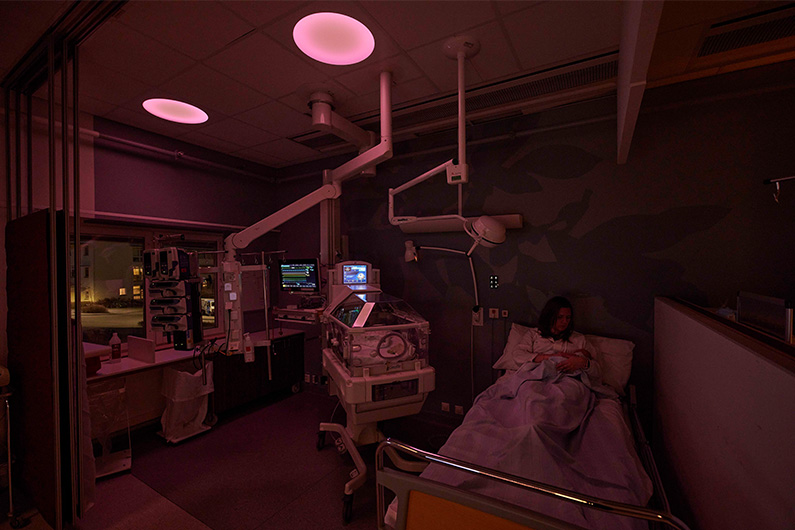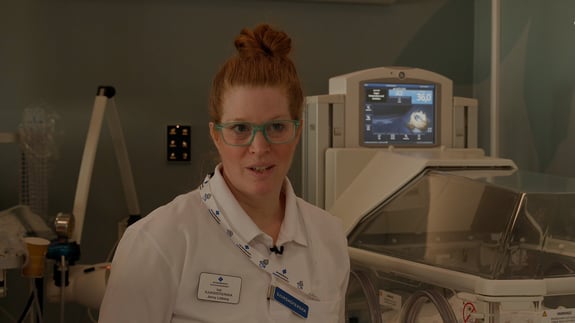A highly successful implementation of evidence-based circadian rhythm lighting has been achieved at the Neonatal Intensive Care Unit at Akademiska Sjukhus Uppsala, where the new lighting solution has significantly impacted staff, patients, and parents.
With the newly installed circadian lighting, the Neonatal Department in Uppsala has managed to find a lighting solution that caters to the needs of both the staff and, most importantly, the vulnerable patients they treat.
The Neonatal ICU cares for the hospital's smallest and most fragile patients – from very premature infants to full-term babies who have experienced complications during pregnancy or birth. However, what these patients have in common is their sensitivity to light, which the department's previous lighting solution failed to address.
— In the past, we always tried to dim the light around the patient by using a cover on the incubators to protect the baby from light. If we couldn't use an incubator cover to shield against light exposure, we always made sure to protect the patient's eyes in other ways to prevent direct light exposure. However, with the circadian lighting system, everything has become much easier because the customized light settings are far better for premature babies than regular white light, explains Jenny Lötberg, an anaesthesia and intensive care nurse at Akademiska Sjukhus Uppsala.
The effect of the light became evident after an extended testing period during which the circadian lighting system was implemented in an intensive care room.
— Here, we found that both premature patients and their parents preferred the more subdued, calm light – especially the pink stimulant light. That's why we chose to install the lighting solution throughout the entire unit, so we now have a lighting environment that suits the department's needs, says Jenny Lötberg.

A Custom-Designed Lighting Solution
The evidence-based circadian lighting has been designed and developed by Chromaviso and is tailored to meet the needs of both the vulnerable patients in the ICU and the unique needs of the staff as well.
— We need slightly different lighting functions depending on whether we’re in an intensive care room, an intermediate care room, or a staff area. In staff areas, we need slightly brighter light, while it should be a bit more subdued in the intensive care, explains Jenny Lötberg, continuing:
— With the circadian lighting system, we find that the lighting is much more tailored to our department activities than the lighting we had before. There is a natural transition between day, evening, and night, which creates a better treatment environment for patients and their parents. But the staff has also benefited from it; in fact, several have reported fewer headaches and better sleep quality after evening and night shifts.

A Mutual Collaboration
The supplier of the evidence-based lighting system, Chromaviso, has been successful in creating a more healing light environment at Akademiska Sjukhus Uppsala, with a particular focus on adapting the light to the underdeveloped eyes and brains of premature patients.
— After discussions with the staff, it became very clear that the prematurely born children, who ideally should have stayed in their mother's safe and dark womb for much longer, were overlooked in the previous lighting solution. Therefore, it was important for both us and the staff to create lighting that protects the sensitive patients while also taking into account the staff's function, explains Greger Johansson, Senior Sales and Relations Manager at Chromaviso.
Chromaviso has been present in the Neonatal ICU to collaborate with the staff and use their expertise in developing the circadian lighting solution.
— We have had a good collaboration where we have received a lot of information. Chromaviso has talked to us in a smaller test group, but also with other staff members and provided us with training so we knew how to approach the light. It's a significant process, but they have ensured that we are all on the same page – and that is very important, concludes Jenny Lötberg.


